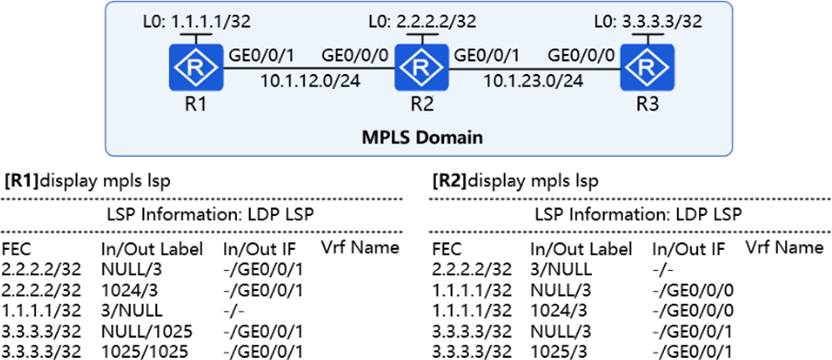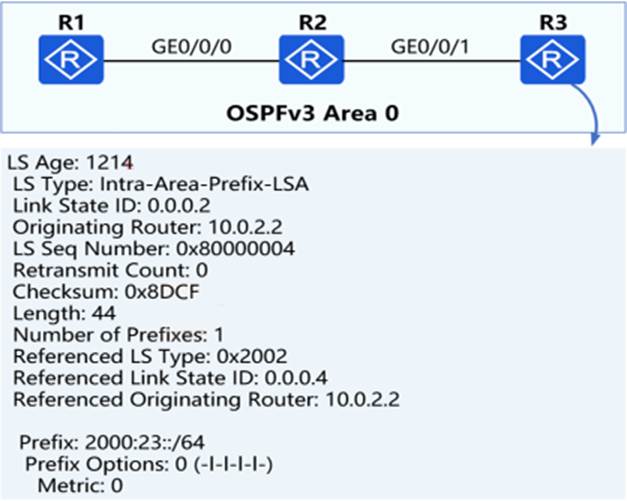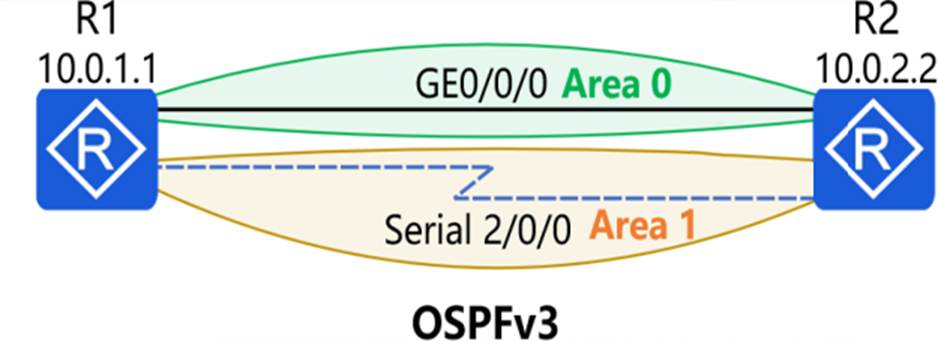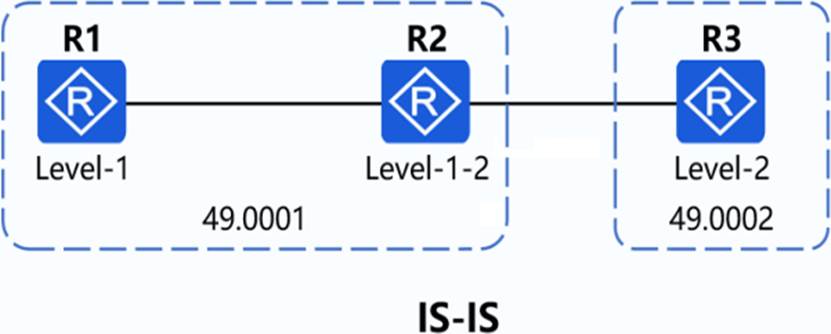Practice Free H12-831_V1.0-ENU Exam Online Questions
In a certain MPLS network, the LSP information of R1 and R2 is shown in the figure. At this time, the administrator enters the command ping3.3.3 on R1.

Which of the following descriptions of this scenario is correct?
- A . The Ping message sent by R1 does not carry any label. After receiving it, R2 will forward it based on IP.
- B . The Ping message sent by R1 will carry label 1025. After receiving it, R2 will remove the label and forward it based on IP.
- C . The Ping message sent by R1 will carry label 1025. After receiving it, R2 will perform label exchange and forward it based on MPLS.
- D . The Ping message sent by R1 does not carry any label, but R2 will add a label after receiving it and forward it based on MPLS
In the OSPFv3 network shown in the figure, the interconnected ports of R1, R2, and R3 have OSPFv3 enabled, and the Router ID of each device is 10.0.X.X, where X is the device number. Check the detailed information of a certain LSA on R3. From the output information, it can be inferred that the LSA is generated by R2, and it describes the IPv6 prefix address associated with the Network-LSA.

- A . True
- B . False
In the OSPFv3 network shown in the figure, area 1 is the Stub area.

By default, which of the following types of LSAs is generated by only one router?
- A . Link-LSA
- B . Intra-Area-Prefix-LSA
- C . Network-LSA
- D . Inter-Area-Prefix-LSA
Which of the following reasons may cause the local device to be unable to learn the ARP information of the other device? (Multiple choice)
- A . The device is attacked by ARP
- B . Link transmission is unstable or optical power is insufficient
- C . The address configured on the interface is not in the same network segment as the peer device.
- D . The physical layer of the connection is not normal
A network engineer provides a troubleshooting report after rectifying a fault. The actual network is simplified into the one shown in the figure, where R1 and R2 both have OSPF enabled and function as the gateways of PC1 and PC2, respectively.
Given this, which of the following statements are true?

Network Topology:
R1:
Interface GE0/0/0: 10.0.12.1/24 (Connected to R2)
Interface GE0/0/1: 192.168.1.1/24 (Gateway for PC1)
R2:
Interface GE0/0/0: 10.0.12.2/24 (Connected to R1)
Interface GE0/0/1: 192.168.1.2/24 (Gateway for PC2)
- A . R2 cannot ping 10.0.12.1.
- B . PC1 and PC2 cannot ping each other.
- C . R1 cannot ping 192.168.1.2.
- D . R1 cannot ping 192.168.1.12.
B, D
Explanation:
Comprehensive and Detailed In-Depth
Understanding the network connectivity:
R1 and R2 are connected through 10.0.12.0/24 and running OSPF in Area 0.
PC1 (192.168.1.11/24) is connected to R1, and PC2 (192.168.1.12/24) is connected to R2.
Analyzing each option:
Option A: "R2 cannot ping 10.0.12.1." ❌ Incorrect
R2 is directly connected to 10.0.12.1/24 (R1) on GE0/0/0, so it can ping this IP without any routing issues.
Option B: "PC1 and PC2 cannot ping each other." ✅ Correct
OSPF is only running between R1 and R2. There is no indication that R1 and R2 are redistributing connected routes (192.168.1.0/24 and 192.168.1.0/24) into OSPF.
As a result, R1 does not know how to reach 192.168.1.12, and R2 does not know how to reach 192.168.1.11, making communication between PC1 and PC2 impossible.
Option C: "R1 cannot ping 192.168.1.2." ❌ Incorrect
Before upgrading or downgrading the system, use the "display ()" command to view the system software, backup system software, configuration files, license files, patch files, and voice files related to the current and next startup of the device.
In the IS-IS network shown in the figure, R1 introduces the default route through the "default-route-advertise always level-1" command.

Which of the following descriptions is correct? (Multiple choice)
- A . There is a default route in R1’s routing table.
- B . There is no default route in R3’s routing table
- C . Although R1 is configured with the "default-route-advertise always level-1" command, it cannot import the default route
- D . There is a default route in R2’s routing table
In a large BGP network, there are many peers, which makes configuration and maintenance extremely inconvenient. For BGP peers with the same configuration, they can be added to a BGP peer group for batch configuration, which simplifies the difficulty of management and improves the efficiency of route publishing. When configuring an IBGP peer group, you do not need to specify the AS number of the peer group. When configuring an EBGP peer group, you must specify the AS number of the peer group.
- A . True
- B . False
In a large BGP network, there are many peers, which makes configuration and maintenance extremely inconvenient. For BGP peers with the same configuration, they can be added to a BGP peer group for batch configuration, which simplifies the difficulty of management and improves the efficiency of route publishing. When configuring an IBGP peer group, you do not need to specify the AS number of the peer group. When configuring an EBGP peer group, you must specify the AS number of the peer group.
- A . True
- B . False
If the cutover preparation is insufficient, which of the following problems may occur? (Multiple choice)
- A . A single board suddenly fails, but there is no spare board
- B . Failure to arrive at the cutover site at the scheduled time
- C . If you do not bring a network cable tester and the port cannot be UP, you cannot determine whether it is a port hardware failure or a cable failure.
- D . Cutover failed, configuration files were not backed up, resulting in service rollback failure
